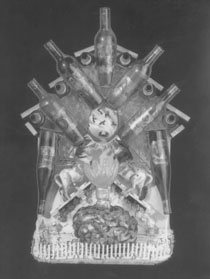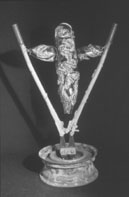Blown Coverage
Photo by MACLA
Nothing is sacred in the glass assemblages of Einar and Jamex de la Torre
By Ann Elliott Sherman
THEY SCULPT in a fragile medium yet refuse to tread softly; indeed, they wield their vision and skill like a very big stick. But unlike the vandal who demolished their first exhibition at MACLA, the San José Center for Latino Arts, a year and a half ago, glass and mixed-media artists Jamex and Einar de la Torre use that stick to poke fun, to prod out of complacency, to see what's under the rocks.
In short, these wizards of the odd use the inside-out consciousness of La Frontera as just the starting point for an intense and far-ranging dialogue.
Mixing mythology, Catholic symbology and political commentary with facts of street life like beer bottles and fake fur, the de la Torres do not do la cultura by the numbers. Their works refuse to reduce cultural icons to an imagination-strangling shorthand or an ethnic self-esteem seminar.
The ready engagement offered by the familiar imagery is played off with incisive wit, opening up the possibility that other nerves can be struck. Levels of meaning bump up against one another, just as the masterfully blown glass is mingled with castoff objects--nails, bolt cutters and painted coins--until the whole work resonates like a fine crystal goblet rubbed with a rudely wet finger.
In this resurrection from what the artists jokingly call "the Macletazo," Jamex and Einar have reclaimed MACLA's gallery space as their own. The power of their determination is evident in pieces like Perra Patria, where the proud eagle of the Mexican national symbol is replaced by an ulcerated, yelping yellow dog wreathed by a two-headed serpent ready to strike.
From hearth and home to men's roving eye, from the motherland to the Holy Father, nothing is sacrosanct. El Papita (The Little Pope) is a worm-eaten, blood-splattered glass calavera sporting a huge miter, with toy chickens where his heart should be and an organ-grinder's monkey on his back.
The all-seeing eyes of God are not in the back of El Papita's head but on the seat of his fur hot pants, and he rides a black cross like a horsy. In this piece, the high craft of the glass skull and miter meets the outsider-art invention of crudely blocked, nail-spiked boots, with additional glass daubs and worms used as embellishment.
While in town, Einar and Jamex have been blowing glass at the San Jose State University glassworks, aided by students and their longtime colleague, John West. As we watched them turn one of Einar's sketched ideas into reality, artist Nora Moore explained, "Working with John allows them to do really large pieces. He's strong and really knows what he's doing because he works with glass all the time, whereas sometimes, having less experienced students' help means you have to adjust your ideas to how things turn out, go with the flow." The brothers do so with a relaxed, gracious direction that belies any disappointment.
Photo by MACLA
UNLIKE THE ART glass of superstar Dale Chihuly, the de la Torres' work is not just about the medium. Instead, they use glass with abandon, making the most of its here-and-now sculptural possibilities to fashion complex pieces given even more telling detail with paint, found objects, lighting and even motorized movement. Just as important as what objects are combined is how and where those things are affixed to the piece.
Einar says, "We're not into content-devoid art or minimalism. The whole idea of having to write about something to explain it suggests that perhaps you should be a writer. Visual art should be visual. If you don't entice me to look, who cares?"
His own incisive gaze turned inward by the threat of testicular cancer, Einar finds a way to make us look at what most would rather ignore. Te Vas a Morir (You're Going to Die) gives us the sonogram of the suspected tumor on a mock TV fashioned out of a candy tin. On a lighter note, there's Los Testiculos de Dios, a fantasy in full flower, featuring an ornate cross adorned with opalescent sequins and Hindu-style flames.
Though known for mining the cultural axis running between the United States and Mexico, the brothers, in fact, traverse in all four directions when harvesting imagery. Kali meets Coatlicue in Virgen del Néctar, Jamex's East-West exploration of the sacred and profane. Her six arms wear the azure, opera-length gloves of strippers and beauty queens. One pair is chained in kinky bondage; another bestows/accepts money; the third ectracts the nectars of life and death from her breasts.
Virtually any aspect of contemporary life comes into play in every sense of that word, from the handgun as a messenger of death (Mano Poderosa) to alcoholism (Visionary Flood of Alcohol). A perceived irreverence may blind the easily offended to how the de la Torres' vision balances the sensational with depth, yin with yang, kitsch with sophisticated taste, criticism with affection.
With so much aesthetic and social commentary operating in hermetic isolation, one feels almost giddy to find artists happily determined to address life in its messy and often contradictory fullness--and to let us all in on it.
[ Metro | Metroactive Central | Archives ]
This page was designed and created by the Boulevards team.

Bottle Up and Go: The glass vessels of addiction assert their dominion in the mixed-media piece "Visionary Flood of Alcohol."
In a Pinch: In "Spiritual Decay,"a bulbous mass of amorphous blown glass is suspended in the arms of a bolt cutter.
Folkloric Acid: The Resurrection runs through Nov. 10 at MACLA's San Jose Center for Latino Arts, 510 S. First St. (408/998-ARTE).
From the October 17-23, 1996 issue of Metro
![[Metroactive Arts]](/arts/gifs/art468.gif)